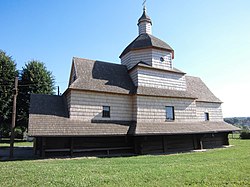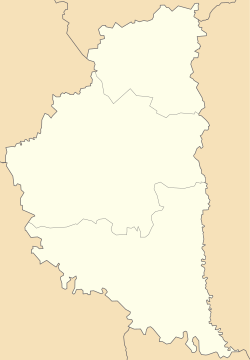Kopychyntsi
This article needs additional citations for verification. (May 2017) |
Kopychyntsi
Копичинці Kopyczyńce • קאפיטשיניץ | |
|---|---|
 Church of Exaltation of the Holy Cross | |
| Coordinates: 49°06′29″N 25°54′46″E / 49.10806°N 25.91278°E | |
| Country | |
| Oblast | Ternopil Oblast |
| Raion | Chortkiv Raion |
| Hromada | Kopychyntsi urban hromada |
| First mention | 1443 |
| Magdeburg Rights | 1564 |
| Government | |
| • City Mayor | Bogdan Kelichavyi |
| Population (2023) | |
| • Total | 7,000 |
| Time zone | UTC+2 (EET) |
| • Summer (DST) | UTC+3 (EEST) |
| Postal code | 48260 |
| Area code | +380 3557 |
| Website | https://kopychyntsi.com.ua |
Kopychyntsi (Ukrainian: Копичинці, IPA: [koˈpɪtʃɪntsi]; Polish: Kopyczyńce; Yiddish: קאפיטשיניץ, romanized: Koptchintz) is a small city in Chortkiv Raion, Ternopil Oblast, Ukraine. It hosts the administration of Kopychyntsi urban hromada, one of the hromadas of Ukraine.[1] Kopychyntsi is the birthplace of Vasyl Ivanchuk, a chess grandmaster; Israel Jacob Kligler, who led the effort of eradicating malaria in Mandatory Palestine; and Pinhas Lavon, an Israeli politician. The population of the town is 7000. The population of Kopychyntsi municipality is 13 965.
History
[edit]| Year | Pop. | ±% |
|---|---|---|
| 1921 | 7,923 | — |
| 1931 | 8,609 | +8.7% |
| 2023 | 6,502 | −24.5% |
| Source: [2] | ||
The city was first mentioned in 1340 as a village in the Polish powiat (county) of Trembowla. With time it grew to become a town within the Land of Halicz, itself part of Podole Voivodeship in the Lesser Poland Province of Poland and then the Polish–Lithuanian Commonwealth. It was granted a city charter in 1564. In late 1648, during the Khmelnytsky Uprising, a combined Cossack and Tartar army under Asand Demko seized the town. However, following the Battle of Kopychyntsi of May 12, 1651, in which the enemy forces were defeated by hetman Marcin Kalinowski, it returned to Poland.
In the effect of the Treaty of Buchach of 1672 the town was ceded to Ottoman Empire, but it returned to Poland after the Treaty of Karlowitz of 1699. Following the Partitions of Poland it became part of Austrian Empire and was then seized by Napoleon Bonaparte who gave it to Russian Empire in the Treaty of Tilsit of 1807. Russian control however ended with the Congress of Vienna which awarded the area back to Austria. It shared the history of the surrounding lands of the Kingdom of Galicia and Lodomeria for the rest of the 19th century.

Following World War I the area was disputed between Poland and the West Ukrainian People's Republic (ZUNR) in what became known as the Polish-Ukrainian War. In June 1919, during the Chortkiv offensive, the 1st Galician Corps of the ZUNR under Osyp Mykytka seized the town, but it was retaken by Polish forces under Józef Haller the following month. Following the Treaty of Riga the town was officially restored to Poland. It was made a seat of a separate powiat within Tarnopol Voivodeship and a garrison town of a Border Protection Corps battalion Kopyczyńce.
Following the September Campaign of 1939 and the outbreak of World War II, the town was occupied first by the Soviet Union until 1941 and then Nazi Germany until 1944. According to the Soviet Extraordinary Commission, approximately 8,000 Jews were killed in Kopychyntsi during the war.[3] After the war, it was annexed by the USSR, and since 1991 is part of independent Ukraine.
Until 18 July 2020, Kopychyntsi belonged to Husiatyn Raion. The raion was abolished in July 2020 as part of the administrative reform of Ukraine, which reduced the number of raions of Ternopil Oblast to three. The area of Husiatyn Raion was merged into Chortkiv Raion.[4][5]


Religion
[edit]Houses of worship
[edit]- Ukrainian Greek Catholic Church of the Exaltation of the Holy Cross and bell tower (1630), located at Kutets
- Church of St. Nicholas on the Mount (1900), architect Vasyl Nahirny
- Roman Catholic Church of the Assumption of Mary (1802) in the center of the town
- Synagogue
Attractions
[edit]- People's House, Kopychyntsi.
- Church of Exaltation of the Holy Cross. The temple was built in 1630, the founder was Martyn Ludetskyi, who at that time owned part of the Kopychyntsi lands.
- Park near the pool, founded in the 18th century;
- Castle (lost).
Partner Towns
[edit] Turkey, Amasra
Turkey, Amasra Belgium, Bruges
Belgium, Bruges Sweden, Höör
Sweden, Höör Italy, Cavarzere
Italy, Cavarzere Poland, Kisielice
Poland, Kisielice Ukraine, Opishnia
Ukraine, Opishnia United Kingdom, Liskeard[6]
United Kingdom, Liskeard[6] Norway, Gjesdal
Norway, Gjesdal
Notable people
[edit]- Vasyl Ivanchuk, Ukrainian chess grandmaster
- Israel Jacob Kligler, Israeli microbiologist
- Mefodiy (Kudriakov)
- Adam Obrubański, Polish football player and manager
- Roman Hubczenko, Polish actor
- Franciszek Slawski, Polish linguist
- Pinhas Lavon, Israeli politician best known for the Lavon Affair
- Mike Mazurki, Ukrainian-American actor
People associated with Kopychyntsi
[edit]References
[edit]- ^ "Копичинецька громада" (in Russian). Портал об'єднаних громад України.
- ^ Wiadomości Statystyczne Głównego Urzędu Statystycznego (in Polish). Vol. X. Warszawa: Główny Urząd Statystyczny. 1932. p. 194.
- ^ "Yahad-In Unum Interactive Map". Execution Sites of Jewish Victims Investigated by Yahad-In Unum. Retrieved 11 February 2015.
- ^ "Про утворення та ліквідацію районів. Постанова Верховної Ради України № 807-ІХ". Голос України (in Ukrainian). 2020-07-18. Retrieved 2020-10-03.
- ^ "Нові райони: карти + склад" (in Ukrainian). Міністерство розвитку громад та територій України.
- ^ https://www.cornish-times.co.uk/news/mayor-of-liskeard-travels-to-ukraine-656470 [bare URL]
External links
[edit]- (in Ukrainian) Сайт Копичинців
- "Kopeczyńce". Geographical Dictionary of the Kingdom of Poland (in Polish). 4. Warszawa: Kasa im. Józefa Mianowskiego. 1883. p. 377.



